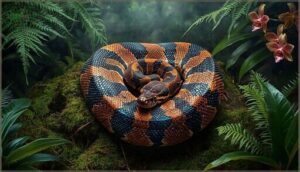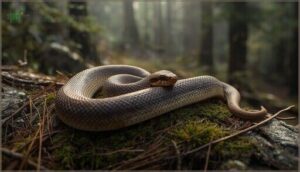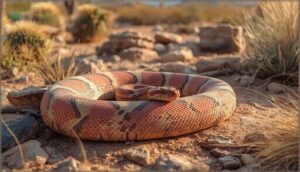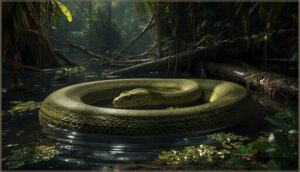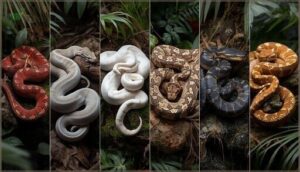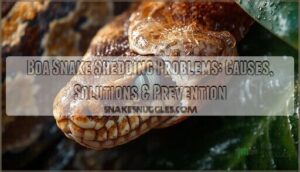This site is supported by our readers. We may earn a commission, at no cost to you, if you purchase through links.
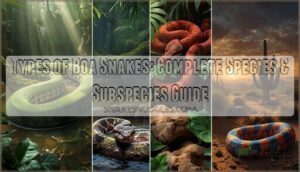
When you think of constrictors, you might picture the familiar red-tailed boa coiled in a zoo exhibit, but the Boidae family holds far more surprises than most people realize. This diverse group contains anywhere from 41 to 67 species, ranging from the colossal green anaconda lurking in Amazonian waters to the pocket-sized rosy boa tucked beneath desert rocks.
Each species has carved out its own ecological niche across the Americas, Madagascar, and Pacific islands, evolving distinct hunting strategies, body structures, and survival adaptations. Understanding the different types of boa snakes reveals not just taxonomic variety, but a masterclass in how evolution shapes predators to thrive in vastly different environments—from steamy rainforest canopies to arid scrublands where water is scarce and temperatures swing wildly.
Table Of Contents
Key Takeaways
- The Boidae family contains 41 to 67 species across 7 to 15 genera, ranging from 30-foot anacondas to palm-sized rubber boas, each adapted to specific environments from rainforest canopies to desert scrublands through distinct hunting strategies and physical traits.
- Boas differ from pythons through key evolutionary markers—they lack premaxillary teeth, retain two functional lungs instead of one, give live birth rather than laying eggs, and possess heat-sensing pits that detect temperature changes as subtle as 0.002°C.
- The boa constrictor species alone branches into ten recognized subspecies with dramatic variation in size, coloration, and geographic range, from the red-tailed South American populations to the critically endangered Argentine boa listed under CITES Appendix I.
- Conservation challenges threaten multiple boa populations through habitat destruction, illegal collection for the pet trade, and climate change impacts, though targeted efforts like captive breeding programs and habitat restoration have successfully recovered some species from near-extinction.
What Are Boa Snakes?
Boa snakes belong to the family Boidae, a diverse group of non-venomous constrictors found across the Americas, Madagascar, and parts of the Pacific. These fascinating reptiles kill their prey by wrapping around it and applying pressure, rather than using venom like their distant cousins.
Understanding what sets boas apart from other snakes—from their physical build to their unique behaviors—will help you appreciate the astounding variety within this family.
Family Boidae Overview
The Boidae family contains 41 to 67 species of nonvenomous constrictor snakes spread across 7 to 15 genera, making it one of the most diverse groups you’ll encounter in herpetology. These boas belong to order Squamata and are closely related to pythons, yet Boidae taxonomy distinguishes them through the absence of postfrontal bones and premaxillary teeth—key evolutionary traits that set this family apart.
They can be found in a variety of habitats, including tropical and temperate zones.
Key Physical and Behavioral Traits
Beyond their shared family traits, you’ll notice that boa species characteristics reveal striking diversity. These snakes possess muscular, stout bodies with smooth scales that enable silent movement, and sensory adaptations like heat-sensing pits along their upper lips detect temperature changes as small as 0.002°C.
Boa species display striking diversity, from muscular bodies with smooth scales to heat-sensing pits detecting temperature changes as small as 0.002°C
Hunting strategies vary from ambush-based to active nocturnal foraging, while social habits remain largely solitary except during mating season.
Defensive behaviors include body inflation and hissing when threatened. They’re also known to be powerful constrictors, using this method to immobilize their prey.
Differences Between Boas and Other Snakes
When you compare boa species with pythons and colubrids, you’ll find distinctions rooted in snake classification and taxonomy that shape how they function and thrive:
- Skull structure: Boas lack premaxillary teeth, resulting in fewer head bones than pythons.
- Lung function: Unlike most snakes, boas retain two working lungs for enhanced oxygen exchange.
- Birth methods: Boas give live birth, while pythons lay eggs.
- Sensory adaptations: Heat-sensing pits along their lips detect temperature shifts as subtle as 0.002°C, refining nocturnal hunting precision.
Major Species of Boa Snakes
When you think about boas, you’re really talking about a diverse family of snakes that ranges from giants lurking in South American rivers to small, secretive species hidden in desert sands. Each major species has evolved unique traits that help it thrive in its particular environment, whether that’s gripping branches in rainforest canopies or burrowing through rocky hillsides.
Let’s look at the primary boa species you’ll encounter, starting with the most recognizable and moving through some of the family’s more specialized members.
Boa Constrictor (Boa Constrictor)
You’ll find the Boa constrictor spanning from Mexico to Argentina, making it the most widespread neotropical boa. Adults typically reach 6.5 to 13 feet, with females outgrowing males—captive breeding has revealed fascinating temperament variations across populations.
| Subspecies | Range | Key Feature |
|---|---|---|
| B. c. constrictor | South America | Red-tailed pattern |
| B. c. imperator | Central America | Variable coloration |
| B. c. occidentalis | Argentina | CITES Appendix I |
Boa constrictor habitats include rainforests, dry woodlands, and even semi-desert terrain up to 2,000 meters elevation. Their calm behavior makes them popular in captivity, though conservation challenges persist—habitat loss fragments populations, particularly threatening island forms. Size extremes vary dramatically: neonates emerge at 20 inches, while outstanding adults exceed 100 pounds. Understanding boa constrictor characteristics helps you appreciate why certain subspecies face greater risks than others in our changing world.
Emerald Tree Boa (Corallus Caninus)
You’ll recognize the Emerald Tree Boa by its striking green coloration and dramatic white dorsal stripes, perfect camouflage within Amazon rainforest canopies. Neonate coloration starts brick-red before transforming to emerald, and captive lifespan reaches 25 years—though conservation challenges persist from pet trade pressures across Corallus caninus populations.
Arboreal adaptations include heat-sensing pits and prehensile tails for moving through boa habitats at 200 meters elevation.
Rainbow Boa (Epicrates Cenchria)
Rainbow boa identification starts with those iridescent scales that shimmer across multiple wavelengths, making Epicrates cenchria unmistakable among boa species.
Brazilian Rainbow Boa populations thrive despite habitat destruction, showing impressive geographic adaptation from rainforests to savannas. You’ll find these nocturnal hunting specialists utilize:
- Ambush predation from ground to 9-meter vegetation heights
- Constriction for subduing mammals, birds, and amphibians
- Ovoviviparous reproduction with occasional parthenogenesis documented
- Adult lengths of 4-6 feet, females exceeding males
- Captive lifespans reaching 20-25 years versus 7-12 wild
Rubber Boa (Charina Bottae)
You’ll recognize Charina bottae by its loose, wrinkled skin and compact body—adults rarely exceed three ounces, fitting comfortably in your palm.
This cold-tolerant species thrives from sea level to over 10,000 feet across western North America, exhibiting exceptional species adaptation.
Habitat conservation efforts focus on protecting these gentle constrictors, as slow reproduction rates make wild populations vulnerable to human disturbance despite their current secure status.
Rosy Boa (Lichanura Trivirgata)
You’ll find Lichanura trivirgata across southwestern deserts, where geographic variants display stunning three-stripe patterns adapted to local terrain. This constrictor snake reaches just 17–44 inches, making captive breeding popular among collectors—unfortunately accelerating habitat destruction through overcollection.
Rosy boa characteristics include heat tolerance and a specialized rosy boa diet of small mammals and lizards, though snake conservation efforts now classify certain populations as threatened, demanding careful attention to preserve wild reptile species.
Anaconda (Eunectes Spp.)
When you picture the Amazon Basin’s apex aquatic predator, green anacondas (Eunectes spp.) dominate freshwater swamps. Their massive, muscular bodies—reaching 30 feet and 550 pounds—execute devastating constriction methods on capybaras, deer, and even caiman.
Recent taxonomic work identified Eunectes akayima as a distinct northern species, separated by 10 million years of evolution from its southern relatives in this heavyweight reptile species.
Boa Constrictor Subspecies and Varieties
While boa constrictors share a common blueprint, the species branches into ten recognized subspecies, each shaped by its unique geography and environment.
You’ll find that these varieties differ in coloration, pattern intensity, and even adult size, with some reaching over nine feet while others remain considerably smaller.
Understanding these subspecies will help you recognize the striking diversity within this single species, from the popular red-tailed boas of the pet trade to rare island forms you might never encounter outside their native habitats.
Red-Tailed Boa Constrictor (B. C. Constrictor)
You’ll immediately recognize the Red-Tailed Boa Constrictor (B. c. constrictor) by its signature rust-colored tail blotches and impressive stature. This subspecies thrives across South America west of the Andes, where habitat destruction increasingly threatens its populations, making snake conservation efforts critical.
Key characteristics include:
- Adults usually reach 6 to 10 feet, occasionally approaching 12 feet
- Tan or brown bodies display approximately 20 dark dorsal saddles
- Females generally outweigh males, staying under 60 pounds
- Red tail morphs vary depending on geographic origin
Understanding constrictor biology and boa behavior helps you appreciate why this boa constrictor subspecies remains popular yet requires responsible stewardship.
Northern Boa (B. C. Imperator)
The Northern Boa (B. c. imperator), another popular boa constrictor subspecies, ranges across Central America and Mexico, adapting to everything from rainforests to grasslands despite habitat loss. You’ll notice 22 to 30 dorsal blotches and dark brown tails, distinguishing this subspecies from its red-tailed cousin.
Imperator care involves understanding their crepuscular snake behavior, boa feeding schedules, and constrictor health needs as they mature from semi-arboreal juveniles to terrestrial adults.
Argentine Boa (B. C. Occidentalis)
The Argentine Boa (B. c. occidentalis) stands apart with its dark brown to near-black coloring and contrasting bright scales, making it one of the most striking boa constrictor subspecies you’ll encounter. This Argentine boa inhabits wetlands between the Andes and Parana River, though habitat loss has reduced its range dramatically:
- Females reach 6-10 feet, weighing around 13.5 pounds
- CITES Appendix I listing reflects serious snake conservation concerns
- Boa behavior remains docile despite agricultural pressures threatening Argentine ecology
Wildlife preservation efforts now target remaining populations.
Amarai’s Boa (B. C. Amarali)
Amarai’s Boa (B. c. amarali) presents a unique challenge among boa constrictor subspecies, recognizable by its unusually short tail and striking “widow’s peak” head pattern. This South American subspecies is found across southeastern Bolivia and southern Brazil, where habitat loss increasingly threatens populations despite CITES Appendix II protections.
| Characteristic | Details |
|---|---|
| Adult Female Size | 5.6–7.2 feet (1.70–2.20 meters) |
| Coloration | Gray-brown (Brazilian) or red-tailed (Bolivian) |
| Litter Size | 10–65 offspring, averaging 25 |
| Conservation Status | CITES Appendix II, Least Concern overall |
Amarali morphs vary dramatically by region, with Brazilian populations displaying dark gray tones while Bolivian variants resemble classic red-tailed boas. Snake behavior remains primarily nocturnal, and boa research confirms juveniles climb more than terrestrial adults.
Understanding boa constrictor classification helps you appreciate how Amarai’s boa occupies rainforest edges and stream habitats, though agricultural expansion continues reducing available territory. Current boa species conservation efforts focus on monitoring trade impacts and preserving remaining Brazilian and Bolivian populations.
Tumbes Peru Boa (B. C. Longicauda)
You’ll recognize the Tumbes Peru Boa (B. c. longicauda) by its spear-shaped head marking and geographic isolation in northwestern Peru’s semi-arid scrublands.
Habitat conservation concerns intensify due to illegal collection for captive breeding, with females reaching seven feet while constricting prey.
This boa constrictor subspecies challenges subspecies identification debates, as snake morphology overlaps with B. c. ortonii, complicating boa constrictor classification despite CITES Appendix II protections.
Mexican Boa (B. C. Sigma)
You’ll find the Mexican Boa (B. c. sigma)—a distinct boa constrictor subspecies and one of the smaller boa species—along Mexico’s Pacific coast, where genetic study confirms its unique sigma taxonomy within boa constrictor species classification.
This Mexican boa constrictor thrives in tropical dry forests despite habitat loss threatening Mexican ecology, making boa conservation efforts critical for protecting populations in Sonora, Sinaloa, and the Islas Marías.
Island and Dwarf Boa Subspecies
You’ll encounter island and dwarf boas wherever insular ecology drives island adaptation, with the Hog Island boa constrictor subspecies exemplifying dwarfism causes—reaching just 5-6 feet compared to mainland relatives’ 14 feet.
Dwarf boas from the Tropidophiidae family inhabit Caribbean territories, while genetic diversity studies support boa conservation efforts for species like the St Lucia boa constrictor, protecting populations threatened by habitat loss and collection pressures.
Habitat and Distribution of Boa Species
Understanding where boas live helps you appreciate the remarkable adaptability of these snakes. They’ve claimed territory across multiple continents, from steamy jungle canopies to bone-dry desert floors, and even isolated island ecosystems.
Let’s explore how different species have carved out their niches in some of the planet’s most diverse environments.
Rainforest and Arboreal Boas
You’ll discover some of the most fascinating arboreal adaptations in rainforests, where emerald tree boas thrive in tropical habitats across the Amazon basin.
These boa constrictor relatives spend their lives coiled on branches, using heat-sensing pits and constricting power to ambush birds and mammals.
Tree boa behavior reflects perfect rainforest ecology, with their green camouflage supporting boa conservation efforts throughout these endangered canopies.
Desert and Semi-Arid Boas
You’ll find impressive boa species thriving where water seems impossible, adapted to arid regions through specialized fossorial adaptations. Desert rosy boas and Kenyan sand boas excel at burrowing behavior beneath rocks and sand, using heat sensing pits to locate prey during cooler hours.
The Argentine boa constrictor and Mexican boa constrictor (Boa sigma) demonstrate how these semi-arid specialists regulate temperature through their underground retreats, emerging strategically when conditions permit.
Island and Endemic Boa Populations
Island ecology shapes extraordinary boa constrictor subspecies you’ll encounter nowhere else on Earth. The Virgin Islands boa and Cayos Cochinos boa exemplify endemic species surviving habitat fragmentation, with dwarf and island boas like the Hog Island boa showing distinct boa genetics from mainland relatives.
These isolated populations face challenging conservation status, though reintroduction programs have restored some communities from near-extinction to several hundred individuals.
Geographic Range by Species
You’ll find boa constrictor habitats stretching from northern Mexico to Argentina, showcasing impressive habitat diversity across deserts, rainforests, and savannas.
Geographic distribution of boa species reveals fascinating patterns: emerald tree boas occupy Amazon Basin canopies, while rainbow boas inhabit Neotropical regions from Nicaragua to Brazil.
Geographic isolation shapes rubber boas in western U.S. mountains and rosy boas in southwestern deserts, making conservation mapping essential for protecting these specialized populations.
Unique Features and Conservation of Boas
Boas display an impressive range of physical traits, from the miniature rubber boa that fits in your palm to the massive anaconda stretching over 30 feet. Their colors and patterns vary dramatically across species and geographic regions, with selective breeding producing even more striking variations in captivity.
Unfortunately, habitat destruction and collection pressures have pushed several boa populations toward extinction, making conservation work critical for their survival.
Color Variations and Morphs
You’ll see stunning diversity in boa constrictor morphs driven by morph genetics and boa pigmentation. Albino boas lack melanin, showing bright yellow or lavender color patterns, while Anery morphs display grey-and-white snake camouflage. Hypo color variants lighten markings through reduced pigment.
Breeders combine these genes to produce rare coloration and pattern variations like the Snow morph, preserving genetic diversity across captive populations and creating visually striking boa constrictor morphs and color variants.
Size Range Across Species
Beyond color patterns, you’ll find striking size variation across boa species that reflects boa morphology and regional differences. Boa constrictors reach maximum lengths between 7 to 10 feet, with sexual dimorphism evident as females grow larger than males. Anacondas exceed 30 feet, while rubber boas fit in your palm at under 3 feet.
Weight variation spans from ounces to 500 pounds, with captive growth often exceeding wild snake species due to consistent feeding.
Threatened and Endangered Boas
While size variation showcases boa diversity, conservation status reveals troubling vulnerability patterns.
You’ll find the Puerto Rican boa proposed for delisting after recovery from endangered status, with populations exceeding 30,000 individuals. Conversely, the southern rubber boa remains threatened since 1971, facing habitat loss from development and logging.
The Argentine Boa constrictor appears in CITES Appendix I, recognizing its critically threatened status requiring immediate wildlife protection and species research.
Conservation Efforts and Human Impact
Conservation efforts now combat the very forces driving boa decline. Habitat restoration projects reverse deforestation impacts, while captive breeding programs address wildlife trade pressures that have decimated populations by 80% in some regions.
Climate change adds urgency to these conservation plans, as temperature shifts threaten reproductive success.
Meanwhile, education campaigns reduce human conflict by dispelling myths, protecting threatened species from fear-based killings that compound habitat destruction challenges.
Frequently Asked Questions (FAQs)
How long do boa snakes live in captivity?
In captivity, your boa constrictor can thrive for 20 to 30 years with proper care.
Though rare conditions sometimes extend snake longevity beyond 40 years, reflecting how captivity factors dramatically influence their aging process.
What do baby boas eat after birth?
Baby boas begin feeding on pinkies—newborn mice—shortly after birth, usually within their first week.
You’ll need to offer appropriately sized frozen-thawed prey every 4 to 7 days to support their rapid growth and nutritional needs.
Can different boa species interbreed successfully?
You might imagine boas mingling at will across species lines, but reproductive barriers keep most separate.
Genetic compatibility exists mainly between Boa constrictor subspecies, where hybridization risks remain low and breeding outcomes viable.
How often do boas shed their skin?
Young boas shed every 4-8 weeks during rapid growth, while adults molt approximately 4-5 times yearly. Your boa’s shedding frequency depends on age, diet, humidity levels, and overall health conditions.
Are boa snakes dangerous to humans?
Boa snakes pose minimal danger to humans. Their defensive mechanisms include non-venomous bites and constriction hazards, but fatalities are unverified.
Understanding their defensive behaviors and following human safety measures reduces snake bite risk markedly during interactions.
Conclusion
Boas bridge bizarre extremes—from water-dwelling giants to palm-sized desert dwellers—each shaped by millions of years of selective pressure.
By exploring the types of boa snakes, you’ve traced evolution’s hand across continents, watching how climate, prey, and isolation sculpt predators into specialists.
Whether you’re drawn to conservation, captive breeding, or field research, this knowledge transforms how you see these constrictors: not as monolithic “boas,” but as distinct lineages, each telling its own survival story.



